Finding the Etruscans
I had first run across the Etruscans in 1975, when Time-Life Books
issued a volume about them, still pretty good today. The Etruscans have
long attracted attention as "mysterious." This just means we moderns
are mystified because no written literary texts, such as philosophies
or memoirs, have survived to explain their way of thinking. We only know
them through archeological artifacts and what other cultures, such as
the Romans, wrote about them.
|
|

Sarcophagus of
the Spouses.
Etruscan.
5th c BCE. Terracotta sculpture.
Villa Giulia, Rome |
|
|
|
|
Today, you can find Etruscan artifacts at two fabulous museums in Rome:
at the Vatican and at the
Villa Giulia.
On
this trip, April 2009, I didn't travel outside Rome, but I did find my way, via
public transportation, to the two museum collections in Rome.
|
|
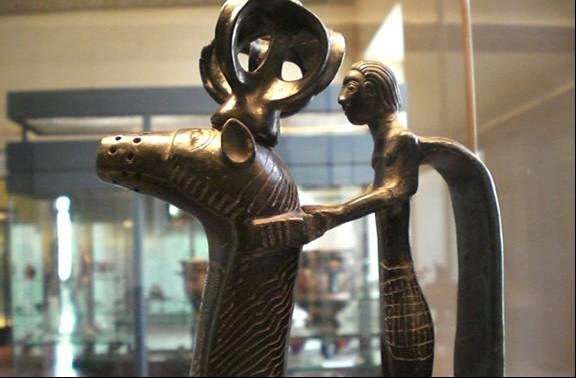
Etruscan: Bronze Figure on Horseback. Gregoriano Etrusco Museum,
Vatican
Museums,
Rome |
|
|
|
|
|
|
|
|
|
|
|
|
The Vatican's Gregoriano
Etrusco Museum
This is a good place to start.
On a bright April day during Easter week, I put on sturdy
walking shoes and hopped on the tram in
Trastevere, connecting easily with a bus across the bridge, to visit the
vast Vatican Museums complex.
|
|
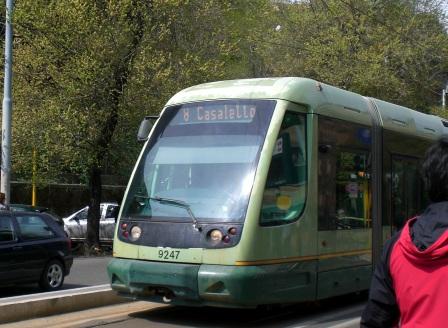
The
trusty tram in Trastevere. |
|
|
|
|
At the Vatican, the Gregoriano Etrusco Museum is located on the second
floor of the complex, same as the Raphael Rooms and the Sistine Chapel,
but at the opposite end of the building. Quite a walk if you visit the
Sistine Chapel first.
No one else was in the Etruscan Museum: eerie to find quiet in the
Vatican Museums. Plus benches.
|
|

Visitors
enjoying the elegant Vatican Museums. |
|
|
|
|
The quiet is at odds with the dynamic, spirited Etruscan objects. These
folks may not have left a literary footprint, but the artifacts found by
archeologists almost shout their military might, religious enthusiasms, and
delight in earthly pursuits.
|
|
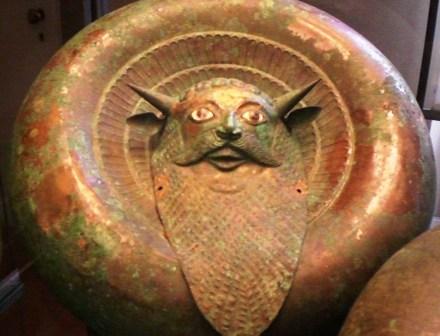 Military shield, ceremonial.
Etruscan. Bronze
Gregoriano Etrusco Museum, Vatican Museums,
Rome.
Military shield, ceremonial.
Etruscan. Bronze
Gregoriano Etrusco Museum, Vatican Museums,
Rome. |
|
|
|
|
Beyond the clamor of some Etruscan art is surprising delicacy in the details, skill in
rendering emotion, and sophisticated working of the material.
|
|
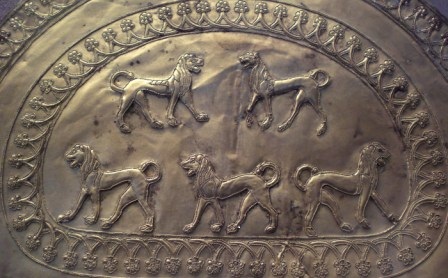
Lions: Jewelry detail.
Etruscan. Gold.
Gregoriano Etruscano Museum,
Vatican Museums, Rome. |
|
|
|
The Mars of Todi
The Mars of Todi warrior: dressed in armor, the
warrior held in his open right hand a cup for
drinking libations, perhaps a supplicating toast to Mars, god of
War. Certainly a pre-battle libation would be needed in the
hand-to-hand-combat of battle tactics of this era. The closed left hand
held an iron spear, now broken into three pieces and in a
display case in the museum.
Hidden for
centuries, the statue was rediscovered in 1935 in a monastery in Todi, an Etruscan settlement on the river Tiber. |
|
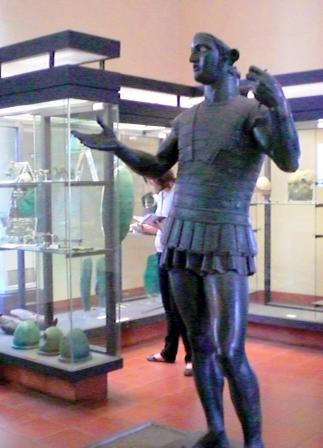
Mars of Todi.
Etruscan. Bronze. Vatican
Museums. |
|
|
|
|
Etruscan Gold Necklace with Lions |
|
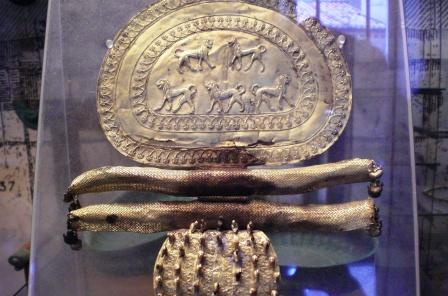
Necklace.
Etruscan. Gold. Vatican Museums. |
|
|
|
|
Bronze shield with one-eyed god
Another Etruscan ceremonial war shield with a god. Over the centuries,
he has lost one eye and part of his beard, inadvertently magnifying the power of his
intensive stare. |
|

Military shield, ceremonial.
Etruscan.
Bronze. Vatican Museums. |
|
|
|
|
Etruscan large gold fibula
A fibula was an ornamental necklace, part ofa dress |
|
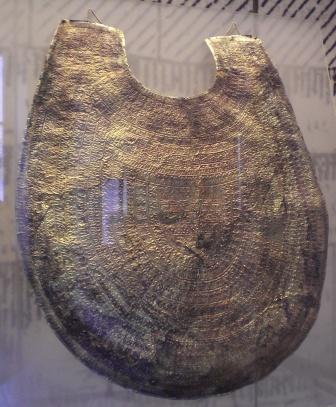
Fibula for dress, ornamental. Etruscan.
Gold. Vatican Museums. |
|
|
|
|
Etruscan gold bracelets
Fabricated around 650 BC, these bracelets came from the tombs at
Cerveteri, Italy |
|
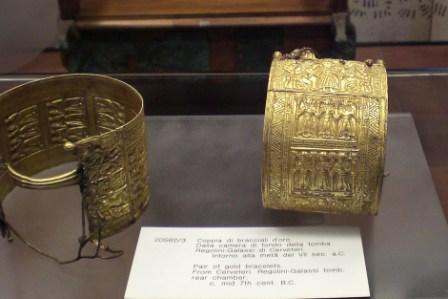 |
|
|
|
Bracelets.
Etruscan c 650 BC. Gold.
Vatican Museums. |
|
|
|
|
|
|
|
|
|
|
|
|
|
|
|
|
The Villa Giulia
My second stop, the following day, was to the north part of Rome, to the
Villa Giulia
(Museo Nazionale Etrusco di Villa Giulia). It's a tranquil setting for this
anything-but-tranquil civilization.
Begun in the 1550's under Pope Julius III as a
summer country retreat, the small villa is worth a visit in
itself. In 1889 the Villa Giulia was taken
over by the state of Italy and became the National Etruscan museum. Over
the next century, the Italian state purchased or was given important
private collections of Etruscan artifacts, including a late 19th c.
replica of an Etruscan temple.
|
|
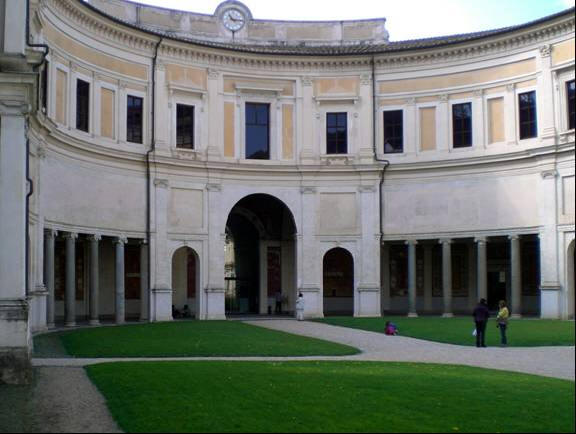
Interior
Courtyard, Villa Giulia. Rome |
|
|
|
|
Today, the Museum houses 30 rooms of artifacts from Etruscan excavations
throughout Italy. The spaciousness of the Villa Giulia is a true gift
for Etruscan studies, since the Etruscans inhabited many city-states,
each with somewhat different resources and culture.
On the female head pictured to
the right, enough of the color pigments remain that you can imagine the
rest of the colors used by the Etruscans, and later by the Romans. The
woman's entire head, not just the bulging eyes and bee-sting lips, was
slathered with vivid shades.
After only two days of Etruscan hunting, I was a
convert. You will be too. |
|
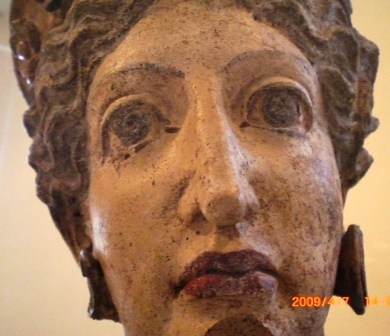
Woman's
head. Etruscan. Painted terracotta, Villa Giulia, Rome. |
|
|
|
|
|
|
|
|
|
|
|
|
|
|
|
|
WHERE TO SEE ETRUSCAN ARTIFACTS
|
|
|
|
|
|
|
|
Rome |
|
|
|
|
|
|
Gregoriano Etrusco Museum, Vatican Museums.
Viale
Vaticano.
Tel +39 06 698 84676
Vatican Etruscan Museum
The Vatican Web site sells tickets in advance.
After lunch and Wednesday mornings after 10:30 are less crowded. Note: the official audioguide is about the growth of the Museums, not a guide to the
galleries.
Full cafeteria dining room and snack bar. Cafes in the vicinity. |
|
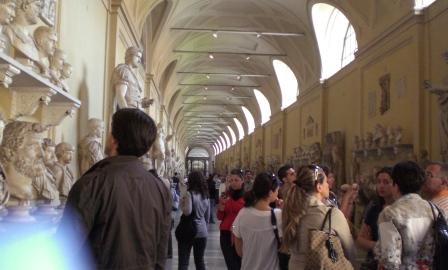
Vatican Museums:
art lovers
and crowds of tourists. |
|
|
|
|
|
|
|
|
Villa
Giulia
Museum
(Museo Nazionale Etrusco di Villa Giulia)
.
Piazzale di Villa Giulia 9,
Roma 00196. Tel. +39 06-320.1951.
For
an English language Web site: Roma2000.
The Villa Giulia is quite uncrowded; advanced tickets are not necessary. When I was there, no
cafe or refreshment facilities were open.
Note: the displays have no English translations.. Buy a guidebook
on the way in or do your research ahead of time. |
|
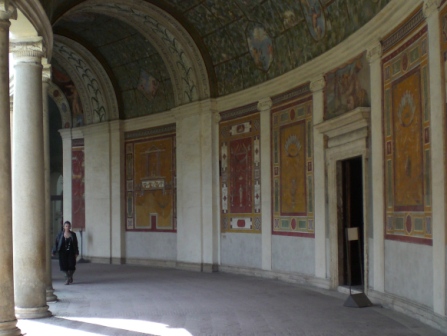
Interior colonnade of the Villa Giulia,
with its 16th C. frescoes.
|
|
|
|
|
|
|
|
|
|
|
|
|
ELSEWHERE IN ITALY
Close to Rome are the ancient Etruscan sites at Cerveteri and at
Tarquinia. Further away:
Bologna was the important
Etruscan city-state called Felsina. Florence has a few ancient
collections, including some Etruscans, though most of Florence is
clearly Renaissance and later. Orvieto, between
Florence and Rome and beautiful to visit, was one of the major Etruscan
hill-top cities.
|
|
|
|
|
|
|
Cerveteri(Caere)
Necropolis Tel: 06-994.0001. No Web site.
About
30 miles from Rome, Cerveteri makes a good day trip from Rome. Famous for its Necropolis some call the town “the
city of the dead.”
At Cerveteri, the Etruscans constructed mound- tombs with rooms, almost
as if you’re visiting someone& home. But note: there are few frescoes in
the tombs. To see painted frescoes, you
need to visit Tarquinia. |
|
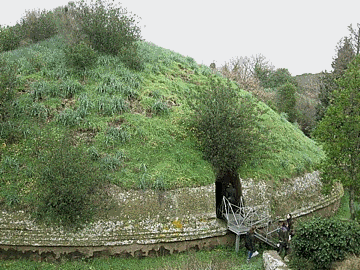
Cerveteri
Mound-Tombs. Visitors descend into the mounds to get to the Necropolis
rooms.
|
| |
|
|
The main burial ground at
Cerveteri is Banditacca. It holds the most
famous tomb in Cerveteri, the Tomba Bella. Belonging to the Matuna family,
representations of the family's possessions, including its pets, were
painted in stucco on the walls.
Although most of the artifacts uncovered at Cerveteri were
moved to the
Villa
Giulia Museum
in Rome,
some remain in its (free) museum.
Museo Nazionale Cerite
in Cerveteri (tel.
06-994.1354); located on the Piazza Santa Maria Maggiore,
within the Ruspoldi Castle. No Web site.
|
|
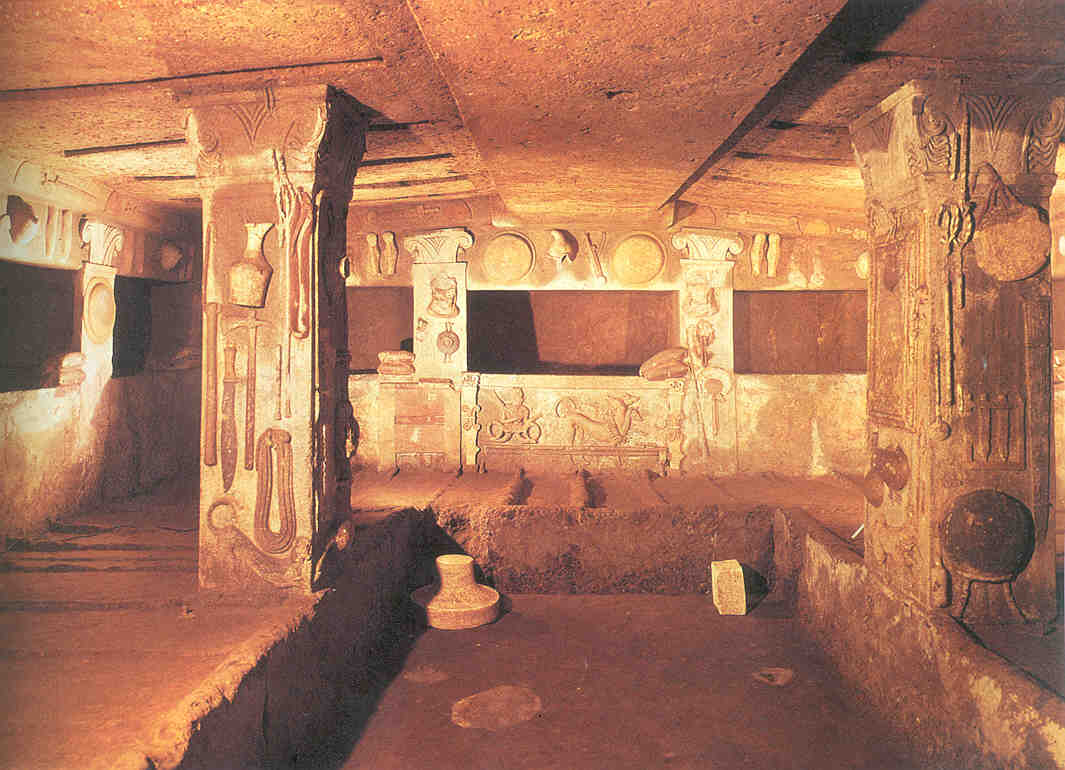
Cerveteri's
main burial ground is
Banditacca,
with its Tomb of the Reliefs,
(Tomba Bella). |
|
|
|
|
|
|
|
|
|
|
|
|
Tarquinia
The
Etruscan Necropolis
of Tarquinia.
Tel.
0766-856.308,
no Web site
Further away from Rome
is
Tarquinia,
with larger and more recent excavations.
The tombs in the necropolis here have the famous frescoes on the walls.
The necropolis area is separate from the museum.
The site covers an area of 2 1/2 miles.
Thousands of tombs have been
located,
some still unexplored.
Unlike Cerveteri, the burial sites in Tarquinia
are not laid out like house-mounds in a city. They are more like individual
mineshafts descending into the earth. Filled with wall paintings whose
colors have survived, the
tombs convey the earthy, vigorous sensuality that the wealthy Etruscans
were noted for. |
|
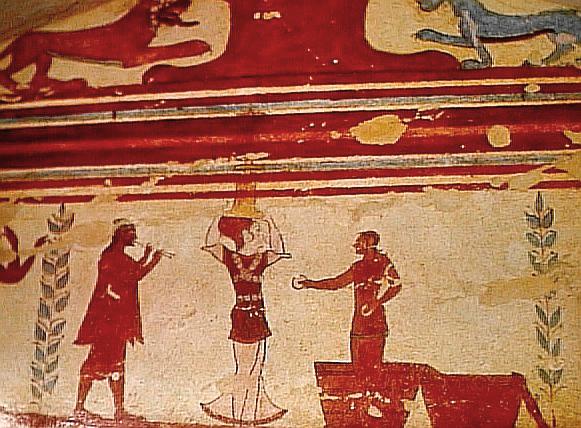
Tomb
of the Jugglers,
Etruscan
Necropolis of Tarquinia. |
| |
|
|
Tarquinia
National
Museum
(Museo Archeologico Nazionale
di Tarquinia). The museum is housed in the Renaissance
Palazzo Vitelleschi, located in the Piazza Cavour.
Tel.
07-76-856.036; no Web
site.
The museum's claim to fame is its pair of life-sized winged horses made
of terracotta
from around 350 BCE.
The
Winged Horses of Tarquinia were found in a
tomb at Tarquinia. |
|

Winged Horses of Tarquinia.
Etruscan. Terracotta. The
National Museum, Tarquinia, Italy.
Photograph by Ulrich Mayring, Wikipedia |
| |
|
|
| |
|
|
Bologna (Felsina) |
|
|
Museo Civico
Via dell'Archiginnasio, 2
Tel. 051 233849
Crammed with antiquities, the museum is located under one of the splendid Renaissance arcades near
the central Piazza Maggiore inside
the Palazzo Galvani. Unfortunately, the museum needs for refurbishment. The Etruscan
artifacts are displayed
in a somewhat dark
and musty interior, reminiscent of museums of a much earlier era. Since
there is sparse labeling and little in English, take a good
guidebook and great patience. No photography allowed. |
|
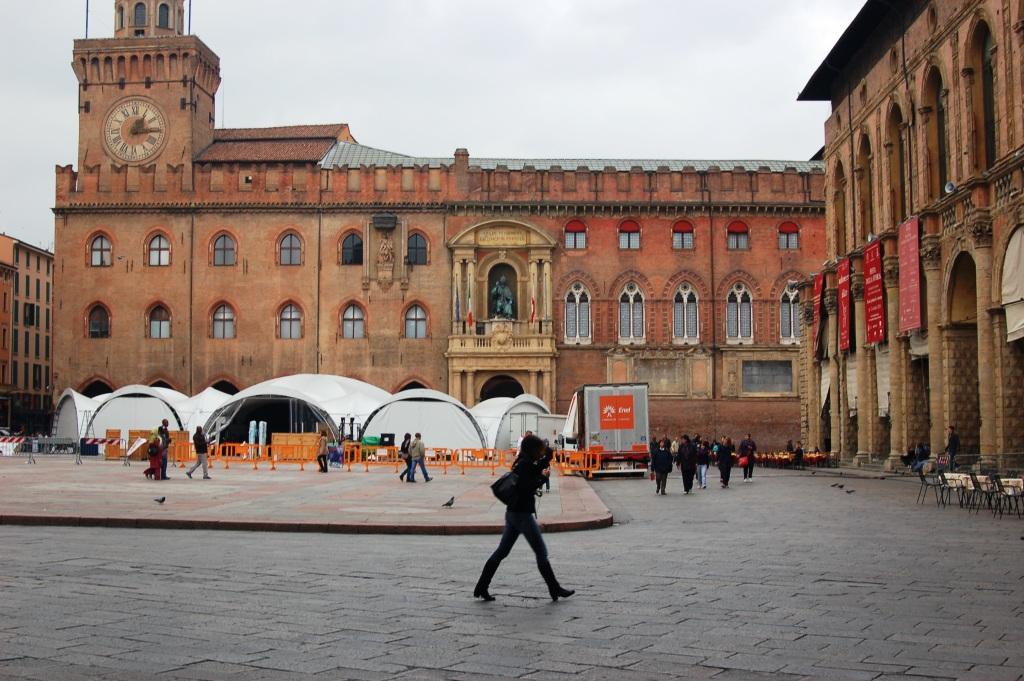
Bologna: the Piazza Maggiore. The Museo Civico is
across the piazza. |
| |
|
|
| |
|
|
| |
|
|
Florence
Museo
archeologico nazionale di Firenze (Florence Archaeological Museum)
Via della Colonna, 36
Tel. +39 055 23575
Among the Renaissance architecture
and treasures that Florence is famous for is the less-well known National Archaeological
Museum of Florence. It is housed in the Palazzo della Crocetta, built
for the grand duchess Maria Madalena of Austria in 1620. No photography. |
|
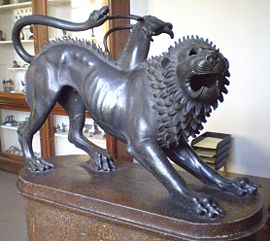
The Chimera di Arezzo.
Etruscan. Bronze. National Archeological Museum of Florence. Photo: Museum |
|
|
|
|
|
|
|
|
| |
|
|
Orvieto
Museo Faina
and
the National Archaeological Museum of Orvieto. These are two separate museums, located on the opposite side of the Duomo.
p.zza del Duomo, 29.
Tel. 0763 341216-341511
Etruscan
artifacts are everywhere, including in the fruit orchards of the B&B
below the town, where we stayed two nights, the most excellent
Casa Selita. The artifacts were
uncovered by a university archeological dig. The owner of our B&B
converted one, not of museum quality, to an outdoor plant container.
|
|
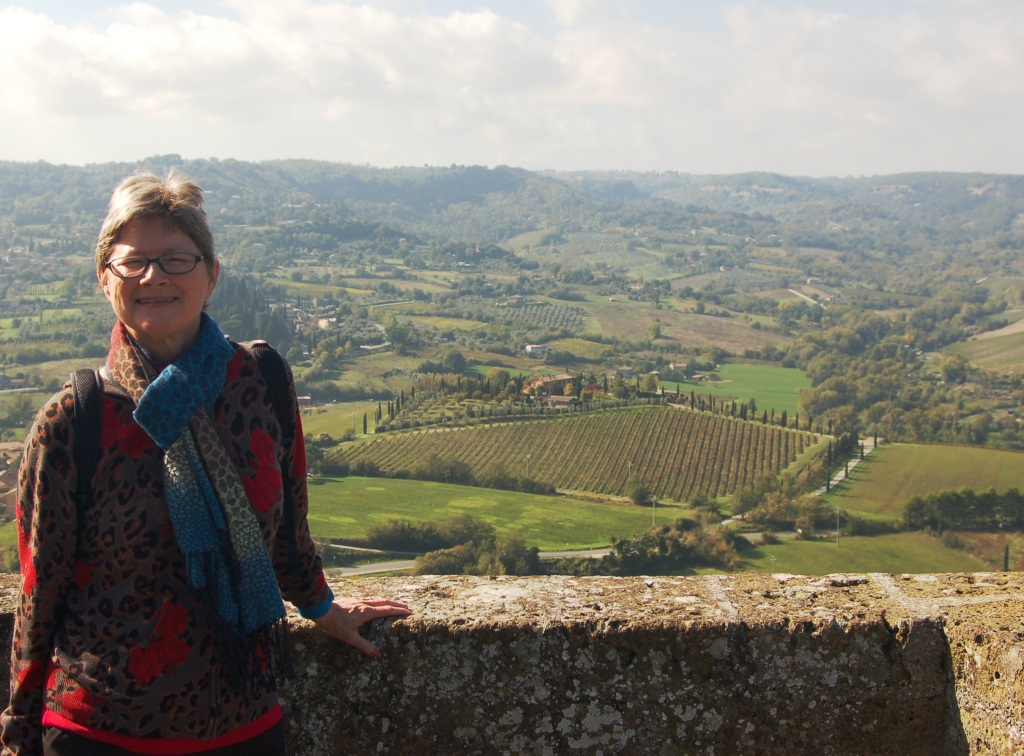
View of surrounding countryside from
city wall, Orvieto.
The commanding heights and
their walls gave the Etruscans protection from most enemy tribes.

Etruscan Tufa, now a plant container.
Casa Selita B&B, Orvieto.
|
| |
|
|
| |
|
|
Or,
find your own
Etruscan tomb.
The Department of
Monuments has road signs throughout the old Etrurian area, denoting
mounds and tumuli.
While on the road between Florence and Siena, we
found this Etruscan burial mound with typical underground shaft in a
small village. We bumped
through (legally) someone's backyard to emerge at a small car park,
mound, and set of four entrances.
Not much down under--no frescoes. You
will need lots of imagination as well as a flashlight. |
|
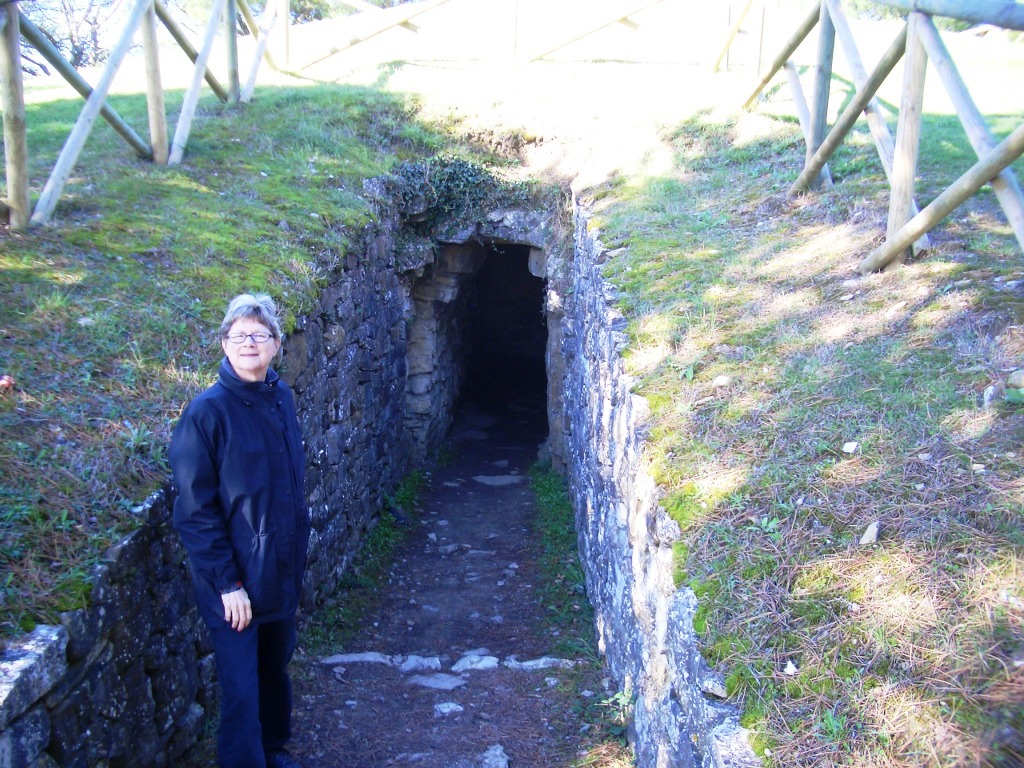
At the entrance to wayside Etruscan mound, on
the road between Florence and Siena. |
|
|
|
|
|
|
|
|
ELSEWHERE IN EUROPE
Can't get to Italy?
There are wonderful Etruscan artifacts
in Amsterdam, Berlin, Munich, Paris, London, and Zagreb.
|
|
|
|
|
|
|
Amsterdam
Allard Pierson Museum (the Archeological Museum of the
University of Amsterdam)
Oude Turfmarkt 127
1012 GC Amsterdam, Netherlands
020 5252556
http://allardpiersonmuseum.nl/english/collections/etruria.html
I was surprised to find-- amidst the Van Goghs, the
Rembrandts, the modern art, and the canals-- this wonderful museum
devoted to archeology.
It's a small Etruscan collection but well displayed.
|
|
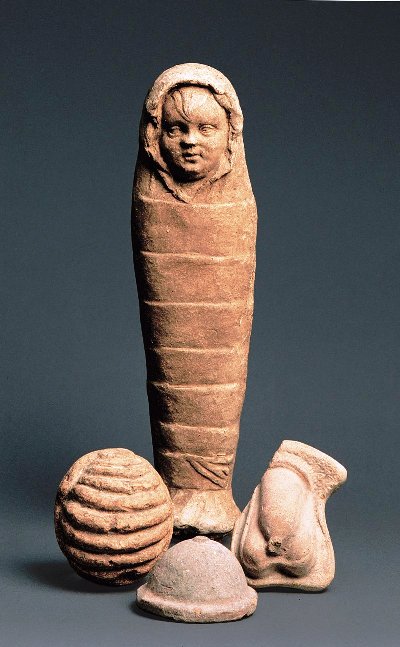
Votive in form
of a swaddled child.
Etruscan. Terracotta. Allard Pierson Museum, Amsterdam.
Photo: Pierson Musuem |
|
|
|
|
|
|
|
|
|
|
|
|
Berlin
Altes Museum
(Staatliche Museen zu Berlin)
Am Lustgarten
10178 Berlin, Germany
030 266424242
Do not miss!
Open Mon-Wed,Fri-Sun 10am-6pm; Thu 10am-10pm. Good Web site in
English.
One of the great museums of the world for antiquities. The
Etruscan and Roman antiquities are installed in spaces that were beautifully
refurbished in July 2010. With
excellent signage in English and good lighting, the classical
collection at the Altes Museum is
well worth an afternoon.
|
|
 Drawing of soldier's military gear.
The gear was
found in grave in Tarquinia, dating 8th c BCE. Altes Museum
(SMB), Berlin Drawing of soldier's military gear.
The gear was
found in grave in Tarquinia, dating 8th c BCE. Altes Museum
(SMB), Berlin
|
|
|
|
|
|
|
|
|
The military shield on the right has rattles fastened to its reverse
side, presumably to frighten the enemy. Some of the clasps of the
soldier's gear were made of gold as well as bronze--a sign of high
social rank.
See more photos at:
Etruscan Artifacts in Berlin |
|
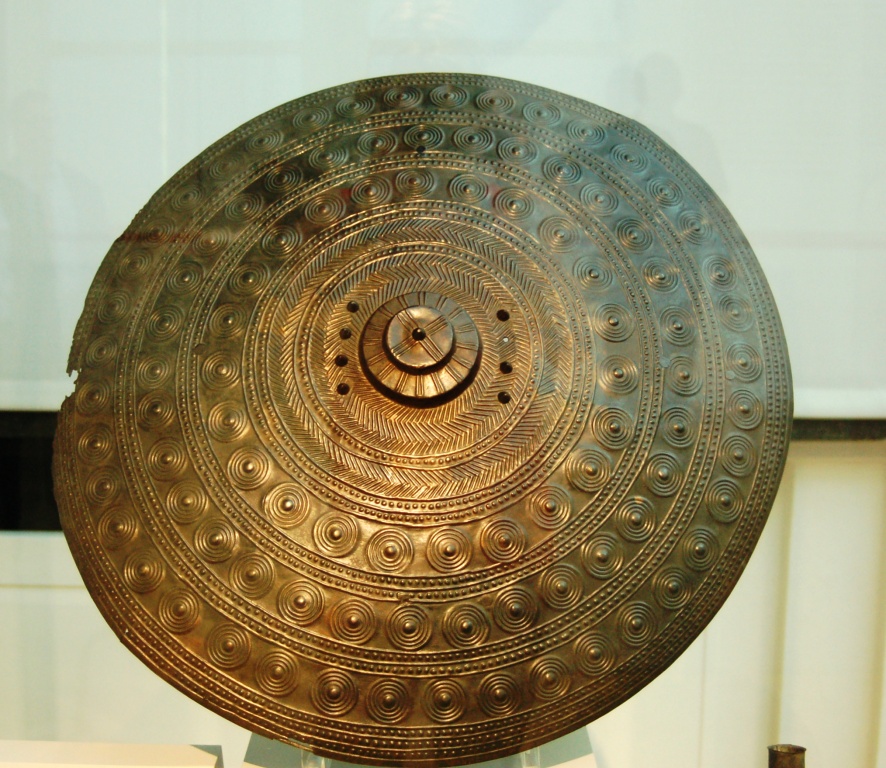 Military
shield. Etruscan.
8th c BCE. Bronze. Altes Museum (SMB), Berlin
Military
shield. Etruscan.
8th c BCE. Bronze. Altes Museum (SMB), Berlin |
|
|
|
|
|
|
|
|
| |
|
|
Munich
Antikensammlungen
(State
Collection of Antiquities)
1
Konigsplatz, 80333 Munchen
(0) 89/599 888 30
I trekked to the state of Bavarian's collections of Etruscan, Roman, and
Greek artefacts, giving up a day of pre-Oktoberfest,
but well worth it.
The collections are housed in a lovely neo-classical building
built by deep-pockets King Ludwig I in 1848. It's the "King's Place."
Across
from it is another neo-classical beauty housing Greek and Roman
sculpture, the Glyptotek.
The objects are displayed in state-of-the-art surroundings.
Though it has a wonderful collection of Etruscan bronze figurines and
jewelry, its
collection of Etruscan pottery is gone, however--lost in World War II to
Alllied bombing raids. No cafe but nice materials in English. |
|
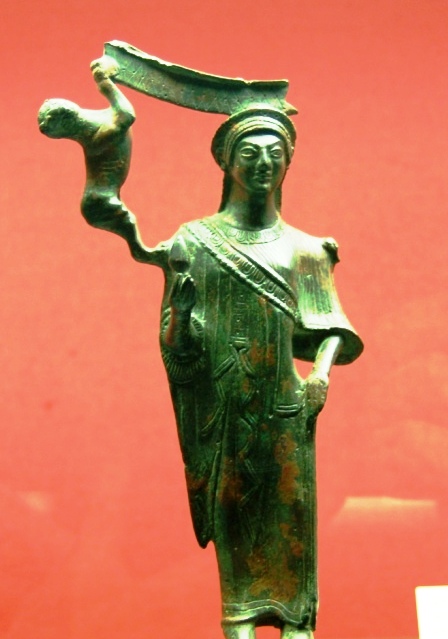
Female with lion(?).
Etruscan. Bronze. Antikensammlungen. Munich |
| |
|
|
| |
|
|
|
|
|
|
Paris
The Louvre: need we say more? One of the great European
collections of classical art.
I visited in spring 2009; be sure and wear good walking shoes--it's
huge. This Sarcophagus of the (Happy) Spouses is virtually identical to
the one in Rome, and to others in the Louvre. |
|

Another
Sarcophagus of the Spouses.
Etruscan. Terracotta. The Louvre, Paris.
Photo: museum |
|
|
|
|
|
|
|
|
IN THE U.S.
Can't get to Europe? The US
has a surprising number of museums with Etruscan artifacts. |
|
|
|
|
|
|
Los
Angeles
The
Getty Villa
17985 Pacific Coast Highway
Pacific Palisades, CA 90272
Do not miss!
The Getty Villa has a wealth of Etruscan,
Roman, and Greek
treasures. The Getty Villa itself is
an amazing re-creation of a Roman villa.
A
magical place all around.
|
|
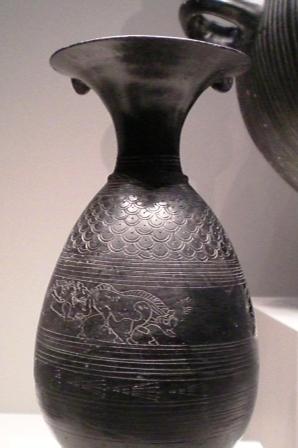
Black (bucchero) incised jug.
Etruscan. Earthenware. Getty Villa, Los Angeles, CA |
|
|
|
|
|
|
|
|
|
|
|
|
Boston
The
Museum of
Fine Arts
100 Huntington Avenue
Boston, MA 02116-6511
(617) 369-6500
The MFA has a nice, well labelled, and not heavily visited collection.
|
|
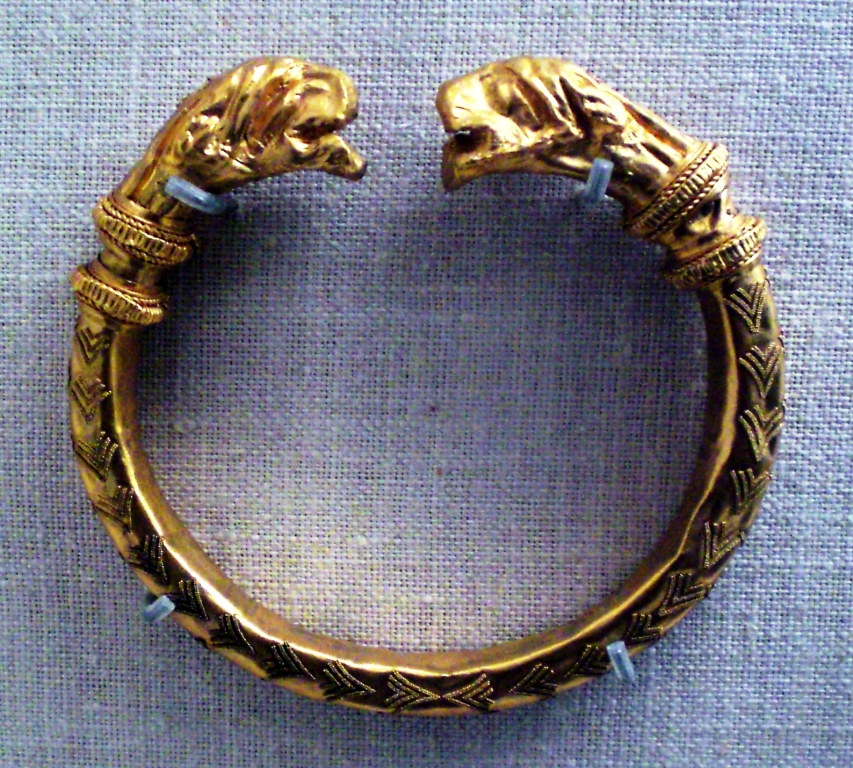
Bracelet. Etruscan. Gold. Boston MFA |
|
|
|
|
|
|
|
|
|
|
|
|
Chicago
The Art Institute of
Chicago
111 South Michigan Avenue
Chicago, Il 60603-6404
The Art Institute, one of the great museums of the U.S., has a
small but interesting collection of Etruscan and classical objects. It
has a budget cafe, good restaurant.
Note how beautifully the Etruscan artist has rendered the horse and
the dog. Although Etruscans borrowed decorative techniques from the
Greeks, they had a different painting style.
|
|

Hunting scene on
storage jar, detail of horse and dog.
Etruscan. Black glazed
terracotta. 5th c BC.
Art Institute of Chicago.
|
|
|
|
|
|
|
|
|
|
|
|
|
New York
The Metropolitan Museum of Art
1000 Fifth Avenue
New York, New York
The Metropolitan Museum of Art, New
York
You can take a dazzling special tour of its
Etruscan collection in the splendidly refurbished Classical
Galleries.
View more photos of
the Etruscan collection at the Met.
|
|
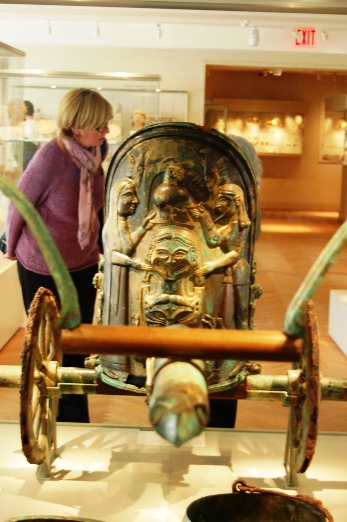 Chariot
of Monteleone.
New York Met Museum. Chariot
of Monteleone.
New York Met Museum. |
|
|
|
|
|
|
|
|
|
|
|
|
New Hampshire
The Hood Museum of Art
Dartmouth College
Hanover NH
At the Hood Museum on the Dartmouth campus, I
found among its classical collections the interesting Etruscan incised jar at the right.
Who knew you could find Etruscan art in New Hampshire?
"Olpe" describes a vessel with a single handle,
usually taller than it is wide. |
|
 Olpe Jug.
Etruscan. 600 BCE. Terracotta.
Hood Art Museum, Dartmouth College, Hanover MA Olpe Jug.
Etruscan. 600 BCE. Terracotta.
Hood Art Museum, Dartmouth College, Hanover MA |
|
|
|
|
|
|
|
|
|
|
|
|
Seattle
Seattle Art
Museum
1300 First Avenue
Seattle, WA 98101-2003
206.654.3100
Great restaurant, open to midnight Thursdays and Fridays.
The
Seattle Art Museum has one
Etruscan artifact. It's nestled among a few Roman and Greek objects, nicely
displayed in a corner of the Museum.
Mirror back incised with scene of the Judgment
of Paris. Typical of Etruscan mirrors, whose artists loved to render the
Greek myths.
|
|
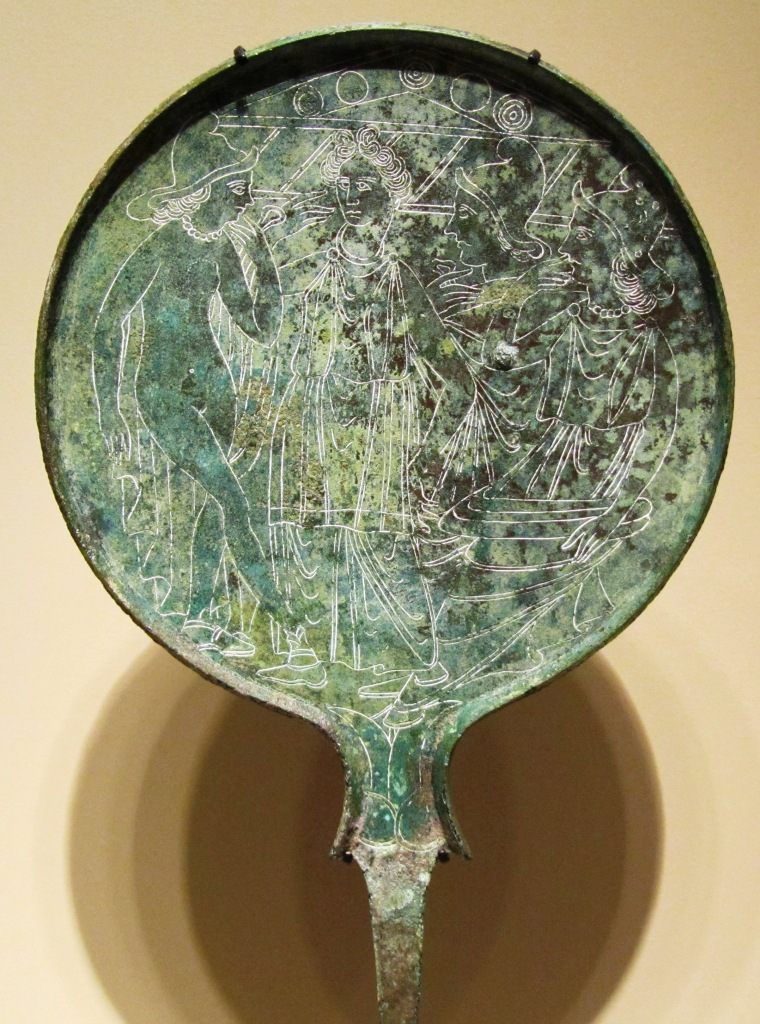
Mirror.
Etruscan.
4th-3rd c
BCE. Bronze. Seattle Art Museum |
|
|
|
|
|
|
|
|
|
|
|
|
Worcester, Massachusetts
Worcester Art Museum
55 Salisbury St.
Worcester MA
In October 2009, I visited the Worcester Art Museum, a vast
building with underappreciated art resources. It's one of those grand
New England cultural institutions, built when Worcester and
Massachusetts had a thriving textile and industrial base. The Etruscan holdings are
few but interesting.
This urn was once brightly painted. The deceased reclines on the lid,
with a flower garland around his neck. Ferocious battle scenes
surround him below.
You may contact me, Nancy Padgett, at
NJPadgett@gmail.com |
|
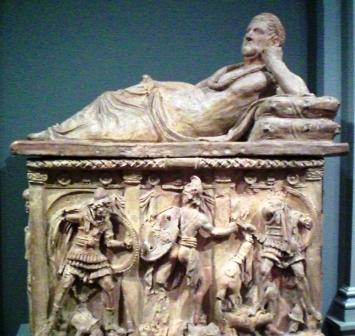
Cinerary Urn.
Etruscan. c. 160 BCE. Marble. Worcester Art Museum, MA |
|
|
|
|